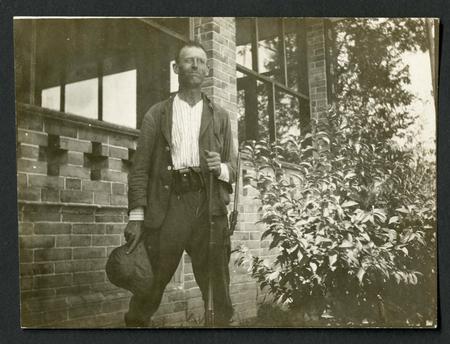
For the past few months, I have had the unique experience of digitizing the David Crockett Graham Field Book Collection which is part of the Field Book Project, a collaborative effort between the Archives and the Smithsonian’s National Museum of Natural History which aims to create one online location for scholars and others to visit when searching for field books and other field research materials. Though many individuals may be unaware of how intrinsically useful Graham's work is to natural history, anthropology, and Chinese cultural studies, the collection is evidence that David Crockett Graham was dedicated to preserving Chinese cultural history and biodiversity. Comprised of diaries (field books), photographs, negatives, lantern slides, hand-drawn maps, an account book, general correspondence, and other miscellaneous material, this collection is a portal for those who seek a better understanding of the biological and cultural landscapes of the Szechwan Province in early-20th-century China. Moreover, it showcases how studies in global biodiversity fit into the multifaceted history of the Smithsonian Institution.
David Crockett Graham (1884-1961) attended many educational institutions in his lifetime. In 1908, he first received a B.A. degree from Whitman College in Walla Walla, Washington. Then, in 1916, he received his B.D. from Rochester Theological Seminary (now Colgate Rochester Divinity School). Later, he would go on to attend the Divinity School at the University of Chicago for postgraduate and doctoral studies. The Smithsonian Institution published Graham's Ph.D. dissertation "Religion in Szechwan Province, China" in 1928. Just a few years later, in 1931, they appointed him with the honorary title of Collaborator in Biology.
![A Chinese [sic] with a broom and a dust-basket. Taken by DC Graham at Suifu, Szechuan, China. This kind of a basket is found on images of servants in ancient Chinese tombs of Szechuan, China. Exactly the same type of a dust-basket was used in Szechuan (apparently) in the Han Dynasty, as is being used today. A Chinese [sic] with a broom and a dust-basket.](https://siarchives.si.edu/sites/default/files/imagecache/body-image-300/blog-attached-images/RU7148_B02_F07-426.jpg) |
Graham began collecting specimens of natural history from Szechwan Province in 1919 for the United States National Museum (now the National Museum of Natural History) during his breaks from missionary work. These specimens included mammals, birds, insects, and snakes. He also sent the museum anthropological data of Chinese cultural groups common in Szechwan Province, such as the Ch'uan Miao, Ch'iang, Lolo, and the Bolstoi people, as well as their representations of folk life and folk art. The diversity of the geographic areas of Szechuan that Graham visited, including the vicinity of Suifu, the Min River Valley, Mount Omei, the Szechuan-Yunnan border, and the Szechuan-Tibetan border regions, is portrayed in his numerous field book entries. Further, with over 600 images in the collection, there is no shortage of visual accounts of Graham’s work as a Smithsonian scientist. The photographs of Chinese indigenous people are fascinating images that truly represent Graham’s multicultural experience.
His field book collection provides international researchers and scholars with incredible insight into some of the cultural communities and physical settings of early-20th-century China. Digitizing his work has taught me more about the diversity of the Szechwan Province. Through reading Graham's field books and closely examining his photo collection, I have become well-associated with his first-hand account of cultural groups, animals and plants. The collection has significantly expanded my knowledge of 20th-century-Chinese history. Even if you have very little interest in biological or anthropological studies, this collection is worth perusing through for a closer examination of a unique historical period and cultural landscape. It will not be long before this collection is fully accessible online, so be sure to check it out!
Related Collections
Produced by the Smithsonian Institution Archives. For copyright questions, please see the Terms of Use.

Leave a Comment